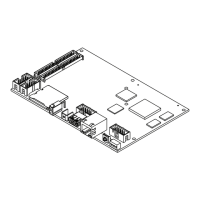© National Instruments 39 NI sbRIO-960x/962x/963x OEM Instructions & Specifications
The first time you power up the device, it attempts to initiate a DHCP
network connection. If the device is unable to initiate a DHCP connection,
it connects to the network with a link-local IP address with the form
169.254.x.x. After powerup, you must install software on the device and
configure the network settings in Measurement & Automation Explorer
(MAX).
Note Installing software may change the network behavior of the device. For information
about network behavior by installed software version, go to
ni.com/info and enter the
Info Code
ipconfigcrio.
Connecting Serial Devices
NI sbRIO devices populated with RS-232 and RS-485 serial ports can
connect to devices such as displays or input devices. Use the Serial VIs to
read from and write to the serial port from a LabVIEW RT application. For
more information about using the Serial VIs, refer to the Serial VIs and
Functions topic of the LabVIEW Help.
Connecting CAN Networks
NI sbRIO devices populated with one IDC header provide connections to a
CAN bus. CAN-enabled NI sbRIO devices have pins for CAN_H and
CAN_L, which can connect to the CAN bus signals. The CAN port uses an
NXP PCA82C251T high-speed CAN transceiver that is fully compatible
with the ISO 11898 standard and supports baud rates up to 1 Mbps.
The port has two common pins (GND) that serve as the reference ground
for CAN_H and CAN_L. You can connect the CAN bus reference ground
(sometimes referred to as CAN_V–) to one or both COM pins. The port
also has an optional shield pin (SHLD) that can connect to a shielded CAN
cable. Connecting SHLD may improve signal integrity and EMC
performance.
CAN Bus Topology and Termination
A CAN bus consists of two or more CAN nodes cabled together. The
CAN_H and CAN_L pins of each node are connected to the main CAN bus
cable through a short connection called a stub. The pair of signal wires,
CAN_H and CAN_L, constitutes a transmission line. If the transmission
line is not terminated, signal changes on the bus cause reflections that can
cause communication errors. The CAN bus is bidirectional, and both ends
of the cable must be terminated. This requirement does not mean that every
node on the bus should have a termination resistor; only the two nodes at
the far end of the cable should have termination resistors.

